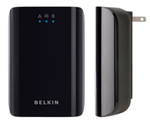Author: Joe Moran
Review Date: 12/9/2009

Price: $149.99 (MSRP)
Pros: fast; easy setup and hassle-free encryption
Cons: bulky and run hot; must connect Gigabit Ethernet-capable devices to realize full performance potential
Since few of us live in homes that are pre-wired for Ethernet, it’s fortunate that the existence of Wi-Fi obviates the need for Ethernet in most home networking situations. But there are times when wirelessly networking a device isn’t feasible, usually owing to excessive distance and/or interference. In such cases, Powerline networking can come to the rescue by allowing you to bring an Ethernet-based data connection to any room in your home via the same copper wires that deliver electricity.
Powerline networking’s been around about as long as Wi-Fi, and like Wi-Fi has evolved over the years to deliver improved performance. Belkin’s Gigabit Powerline HD Starter Kit (Model # F5D4076) represents the latest and greatest iteration of the technology—based on a new chipset from Gigle Networks which is exclusive to Belkin as of this writing, the $149.99 kit includes a pair of adapters that boast the same 1000 Mbps theoretical data rate as Gigabit Ethernet, well in excess of the 200 Mbps of existing Powerline devices or the 300 Mbps quoted by current 802.11n products.
Belkin’s wall-wart powerline adapters are clad in glossy black plastic with a trio of indicator lights on the front panel. They’re a bit on the chunky side, measuring 4 ½ x 3 ½ x 1 ½ (HWD), but since the bulk is all south of the AC plug, when you use a bottom outlet the top one won’t get blocked. It’s worth mentioning that the adapters run extremely warm—hot, actually, since in some spots they become almost too toasty to comfortably touch.
Setup and Security
Powerline adapters have always been relatively easy to set up provided you didn’t care about a secure connection. On the other hand, enabling encryption on them usually makes configuration more complicated, involving a software utility (running on a Windows PC), and the need to enter a password that’s a long string of alphabetic characters. While encryption on a powerline network isn’t quite the imperative that it is with Wi-Fi, it’s still important, because powerline data signals traverse circuit breakers and halt only when they reach an electrical transformer. (Transformers shared between multiple households are a given in any multi-unit dwelling, and they’re also quite common among detached single-family homes.)
Thankfully, the Belkin adapters don’t require a cumbersome security configuration process since they come out of the box with encryption turned on. Plug the pair of devices into their respective wall outlets, and they automatically negotiate a 128-bit encrypted link via a preconfigured passphrase. The powerline network’s encryption status is shown via one of the adapter indicator lights; the other two denote the quality of the Powerline connection (either above or below 200 Mbps) as well as the presence of Ethernet connectivity to an attached device. A pushbutton atop each adapter lets you re-sync them to a new encryption passphrase.
Within seconds of plugging the Belkin adapters directly into wall outlets several rooms apart (plugging powerline adapters into surge suppressors or battery backups is a recipe for poor network performance due to the power filtering those devices perform) and connecting them to a router and a PC, the latter had received an IP address via DHCP and was up and running on the network.
Performance
We used iPerf to gauge how fast data could travel between a pair of Gigabit Ethernet-capable Windows 7 PCs using the Belkin adapters as the conduit, and the results were impressive. The tests consistently measured throughput of between 220 and 265 Mbps, which was anywhere from two to three times higher than powerline or MoCa networking products we’ve previously tested. Even better, the throughput held up when we configured the iPerf to transmit two, four, or eight parallel streams, indicating that the Belkin should easily handle heavy traffic generated by multiple attached devices. (Although the adapters only provide one Ethernet port, you can connect additional devices via an inexpensive switch.)
The level of performance you ultimately wring out of the Belkin powerline adapters will depend on the capabilities of devices you connect to them, as connecting either adapter to a device with a mere 100 Mbps Fast Ethernet port can represent a potential bottleneck. That’s an important thing to remember, because while many desktop and notebook PCs and routers sport Gigabit Ethernet ports these days, they’re far from a given. Moreover, most consumer electronics devices—game consoles, streaming devices, and set top boxes/DVRs etc., make do with 10/100. (Sony’s Gigabit- capable PS3 is a notable exception.) That said, an HD data stream is considerably less than 100 Mbps, and we had no problem streaming high-quality HD video to a TiVo, Xbox 360, and PlayStation 3 using the Belkin kit.
Despite the implication of “starter kit” in the product name, the Belkin adapters aren’t currently available individually. While that won’t be an issue for most, it will be for those that want to use the Belkin adapters to network devices in two separate locations back to a router, thus needing three devices. For situations where you need more than two devices, it’s worth noting that Belkin says its Gigabit adapters will interoperate with—as opposed to simply co-exist with—older 85 Mbps HomePlug AV powerline products (though we weren’t able to test it ourselves).
When wireless won’t cut it and you need a high-performance, low-hassle way of networking devices around the house, the speed and easy setup of Belkin Gigabit Powerline HD Starter Kit won’t disappoint you.




